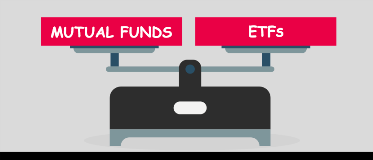How ETFs are different from mutual funds?

Last Updated: 11th June 2019 - 03:30 am
3 min readWe usually use the terms mutual funds and ETFs interchangeably. Conceptually they are both the same. An exchange traded fund (ETF) is also an example of fund manager managing retail money in a professional manner with the benefit of diversification. To a large extent mutual funds are also the same thing. To begin with ETFs and mutual funds are very broad concepts but for simplicity of understanding we will restrict ourselves to a comparison of index funds and index ETFs.
Index funds, Index ETFs and passive investing
The first thing you need to know is that, both index ETFs and index funds are instruments of passive investing. In fact, ETFs are best utilised in case of passive positions on an index or the economy. Index ETFs and index funds represent two common methods of investing passively in the equity markets. The whole idea of passive investing is to mirror the index and not to beat the index. Beating the index is the job of an active fund manager. Passive funds like the index ETF and the index fund are purely focused on tracking the index. The entire effort, therefore, is directed at reducing the tracking error to the bare minimum.
Conceptually the same but structurally different
That best describes the distinction between index ETFs and index funds. As mentioned earlier, both the index fund and the index ETF essentially mirror an index. Such indices could be the Nifty, Bank Nifty, Nifty Mid Cap or even global indices and commodity benchmarks. Here are some of the key points to know about an index mutual fund versus an index ETF.
-
An index fund is like any normal mutual fund scheme. The only way the index fund differs from an active fund is that the active fund manager tries to create alpha for you. An index fund does not create alpha but only minimises tracking error. Even in case of index ETFs, the focus is on reducing the tracking error and minimising fund costs.
-
The tracking error reflects the extent to which the index does not mirror the index (higher or lower). Ideally, for index ETFs the tracking error should be as low as possible. For mutual funds in general, tracking error is not relevant but for an index fund it is fairly important.
-
Index funds, like other open-ended funds, are open to purchase and redemption at any point of time. Index funds are normally open ended. This is in contrast to the index ETF, where any purchases or sale is not done by the fund. Such transactions are effected in the market between buyers and sellers.
-
Consequently, the number of units of a mutual fund and the AUM of the index fund keep changing. On the other hand, the AUM and the number of units of an index ETF do not change as it is closed ended. Once the NFO is closed, there is no further addition to the corpus, other than the value accretion.
-
Mutual funds, including index funds, issue units which are valued after adjusting the total expense ratio (TER). On the other hand, ETFs trade in fractional shares of the index or the underlying commodity. For example, one fractional share of the gold ETF typically quotes at 1 gram gold so the market price is 1/10th of the gold spot price.
-
Let us look at the operational process flow of an index fund versus an index ETF. When you buy index fund units from an AMC it increases the AUM of the fund. When you redeem, the AUM reduces. In the case of an Index ETF you can buy or sell only if there is a counter party to the trade (liquidity in the market). So, liquidity is the key in index ETFs and their AUM will only increase when the value of the fractional shares goes up.
-
In case of an index fund purchase or redemption will be executed at the end-of-day (EOD) NAV. The NAV is the net asset value based on the market value of all stocks adjusted for the total expense ratio (TER) on a daily basis. In the case of an index ETF, prices vary on a real time basis.
-
The reason index ETFs became popular in India is that cost of Index ETF is much lower than index fund. Index funds have an expense ratio of around 1% while index ETFs have an expense ratio of about 0.35%. Of course, in addition, there is the brokerage and statutory charges but still index ETFs work out cheaper.
-
One area where index funds score over index ETFs is that you can structure a systematic investment plan (SIP) in an index fund. Today, Indian mutual funds get SIP inflows of close to Rs.8200 crore each month. SIPs offer rupee-cost averaging which lowers the average cost of owning the units. Index ETFs, being closed ended, do not support SIPs.
-
A key advantage that ETFs have is that they can be structured as long or short or leveraged products. That is not possible in mutual funds, although such exotic options are still not available in the Indian markets.
- Flat ₹20 Brokerage
- Next-gen Trading
- Advanced Charting
- Actionable Ideas
Trending on 5paisa
Disclaimer: Investment in securities market are subject to market risks, read all the related documents carefully before investing. For detailed disclaimer please Click here.

 5paisa Capital Ltd
5paisa Capital Ltd